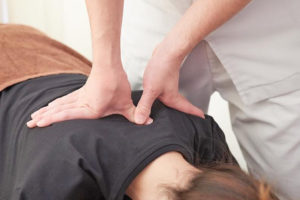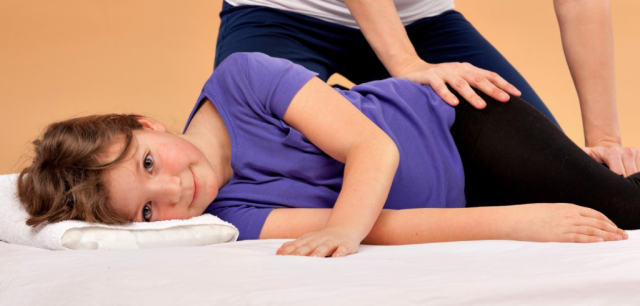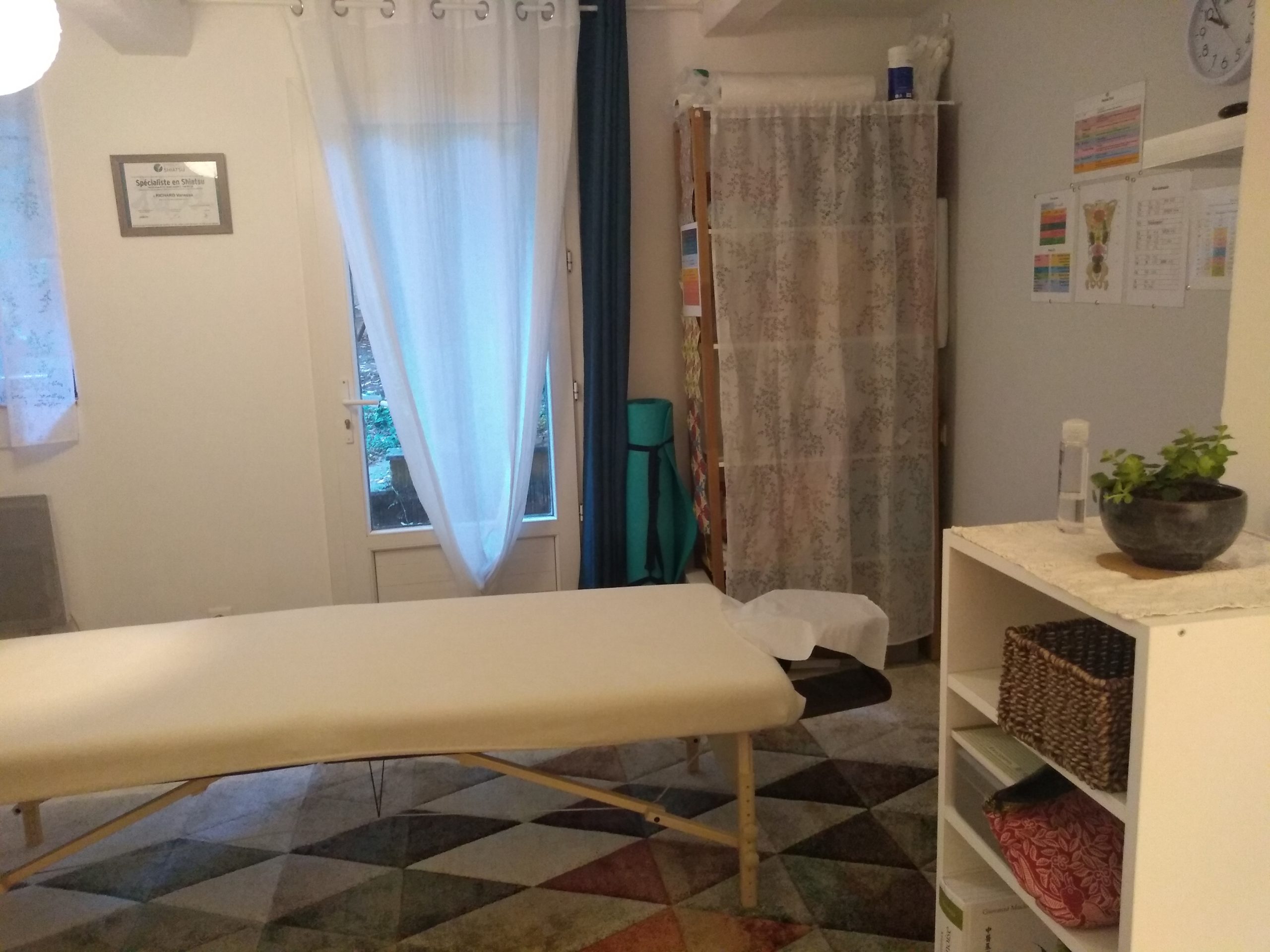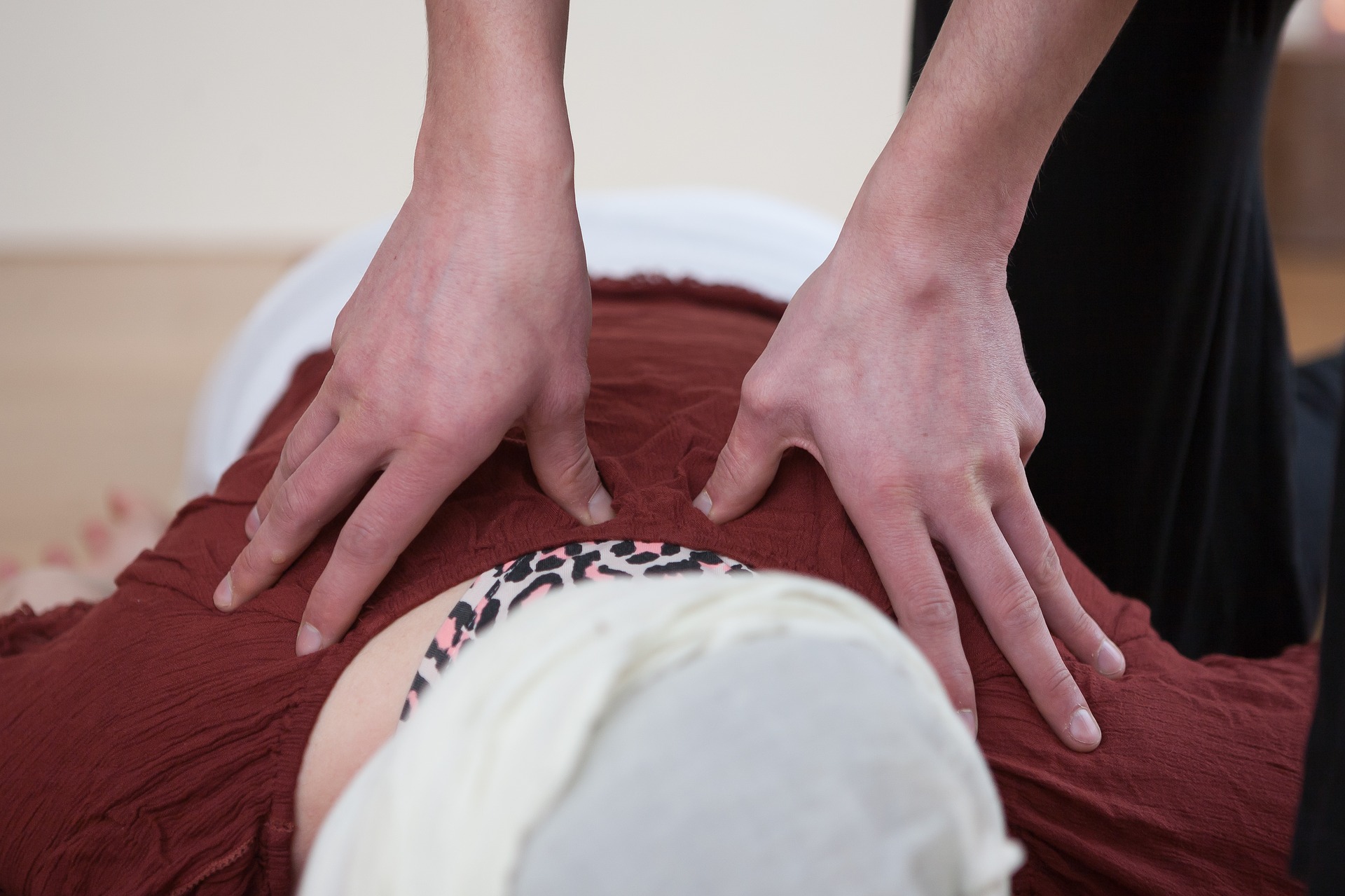Shiatsu is a Japanese term meaning « finger pressure. »
This health practice is based on a holistic approach of each individual. It combines action on energy meridians–and other key zones of the body–with work on muscle chains, tissues and fascias.
One may say it is at the crossroads of acupuncture and osteopathy. It is received fully dressed.
Its purpose is to harmonize (prevention) and contribute to easing the body’s dysfunctions (correction) so that it works at the best of its own resources, at physical, emotional and psychological levels.
For whom and for what?

Shiatsu takes into account individuals as a whole: the work will be specific to each person, based on their physical, emotional and mental condition.
It is
suited to every age and physical condition. Based on the principles of ‘Chinese medicine’ and on anatomy/physiology principles–close to those of osteopathy and fasciatherapy–, shiatsu can effectively ease a number of conditions.
It is particularly efficient on stress, anxiety, fatigue, and boosts psychological and emotional harmony.
Indications
Shiatsu stimulates the body’s natural defences, fosters the good functioning of the nervous system and that of endocrine glands, stimulates the blood, lymphatic and energetic circulations, improves the flexibility of muscular tissues,
corrects minor skeletal defaults.
The most frequent reasons for a shiatsu session are:
– back aches: lumbago, neck pain, sciatica…
– stress, anxiety, nervosity, ‘light’ depression, burn-out
– daily well-being of people suffering from fibromyalgia (provided they can be touched), arthrosis, arthritis, rheumatism…
– covid after-effects, long covid, covid vaccination side effects
– digestive problems: nausea, diarrhoea, constipation, sour stomach and oesophageal reflux, slow intestinal transit, bloating, gallbladder issues…
– neurovegetative issues: chronic fatigue, headaches, sleep issues, spasmophilia…
– accompany alcohol or nicotine withdrawal
– periods dysfunctions, fertility and menopause issues
– sinusitis; asthma; dry eye syndrome; heavy legs…
Contra indications
There is no contraindication to shiatsu–except of course if your practitioner suspects you’re having a heart attack, a stroke or a thrombosis.
Shiatsu will be careful and adapted in case of:
– pregnancy
– history of thrombosis or phlebitis or else significant blood circulation issues; advanced osteoporosis, recent fracture or burn, infectious disease, very high blood pressure, serious heart or liver disorders, cancer
– serious psychiatric condition (bipolarity, schizophrenia…)
The only two contraindications are actually dictated by prudence:
– Amyotrophic Lateral Sclerosis (also known as ALS or Lou Gehrig’s disease) since we don’t know whether shiatsu pressure can contribute to spreading the disease,
– and some cancers and metastatic cancers.
Shiatsu is not a substitute for a medical treatment. In case of doubt or chronic illness, please contact your doctor to check whether shiatsu suits your condition.
What about children?

The energy system of children (3 to 12 yo) is constantly changing: sessions are shorter, and they’re based on their present moment needs. As a consequence, we work on symptoms–for example bed-wetting–and not on the energy background.
The pace, the kind of pressure and the duration of the session are determined by the child.
What is a typical session like?
One single session might be enough to bring the body back to a good energy functioning or solve a physical blocking, such as some sciatic pains. In most cases however, and in particular if the reason why you came is a dysfunction that’s been here for years, it takes at least 3 to 4 sessions to initiate and then consolidate the energy adjustment process. Then, if need be, it is your needs or the type of dysfunction which determine the frequency of shiatsu sessions.
There is no specific frequency for « well-being » shiatsus: you can have as many shiatsus as you want, whenever you want!
As regards « maintenance », it is advisable to come during a change in energy season–the Chinese calendar transition times usually called the 5th Season–, roughly:
- between30 October and 15 November: Autumn turns into Winter
- between 21 January and 10 February: Winter turns into Spring
- between 27 April and 12 May: Spring turns into Summer
- between 29 July and 15 August: Summer turns into Autumn

More on shiatsu practice
Shiatsu is a Japanese discipline based on the principles of Chinese medicine. Shiatsushis (shiatsu practitioners) use their thumbs, fingers and palm to press along specific channels, zones and points.
The World Health Organization (WHO) states that shiatsu belongs to the ‘traditional medicine’ category, and the European Parliament lists it in the « Complementary and Alternative Medicine » category.
In France, since July 2015 the Professional Practitioners’ Union (Syndicat des Professionnels de Shiatsu) has obtained that the professional certification ‘Spécialiste en Shiatsu’ be included in the Registre National des Certifications
Professionnelles (RNCP). Thus, The RNCP title ‘Spécialiste en shiatsu’ is an officially recognized certification.

Shiatsu isn’t a massage, or a medical practice in the Western sense of the term. For lack of rules concerning the practice of shiatsu, it is considered in France to be a natural energetic discipline based on touch, which belongs to the domain of health improvement, as a health practice complementary to conventional medicine.
♦ Please note that shiatsu is not reimbursed by the French Social Security. Certain
mutuelles may cover part of the fee, depending on the guarantees you subscribed to.
